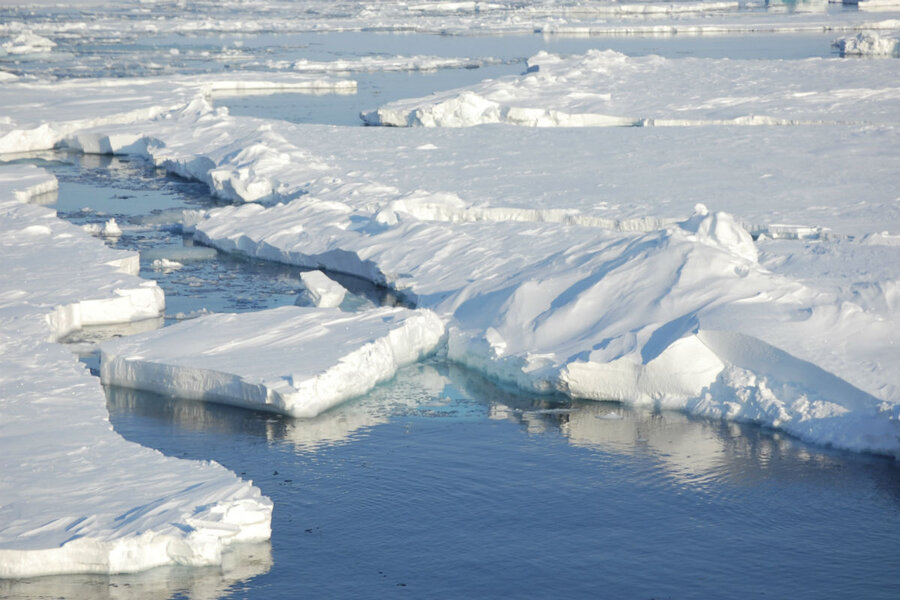Once-in-a-decade heatwave melting the Arctic ... for the third time this year. Why?
Loading...
Records are shattering left and right across the Arctic, much like the ever-dwindling sea ice that once covered the entire Arctic Ocean.
First, the facts. January sea ice area has never been so small. In November, the coverage fell short of average by an area the size of the eastern half of the United States. Northeast Greenland had its warmest February day ever (by almost four degrees). The current heat wave brought Friday’s temperatures near the North Pole to 50 degrees above average, which is like New York City having a January day in the mid-80s.
This kind of unprecedented weather leaves even seasoned researchers scratching their heads.
“We’re still trying to figure out what is happening here,” Mark Serreze, a senior research scientist with the Colorado-based Snow and Ice Data Center, told KUAC. “The sea ice is so low there in part because it’s just been so darn warm in the Arctic this winter.”
Of course, there’s a huge difference between weather and climate. The Earth is a vast and chaotic system, and heat waves as well as cold snaps can happen anywhere. But how often they take place can give insight into general patterns.
According to a paper published two months ago in Nature, these hot spells normally "occur once or twice each decade, with the earliest identified event taking place in 1959."
Now, we’re on our third one this year.
Everyone agrees that "something is very, very wrong with the Arctic climate," as Mashable's science editor tweeted on Wednesday. Scientists know that the meltdown results from the complex interaction of players including emissions-driven climate change, warm air and water, and shrinking ice area. Divvying up blame is tough, but the general trends are clear.
Normally, this time of year is winter in the arctic, although you might not know it from this week’s balmy 40-degree temperatures in Svalbard, an island halfway between Norway and the North Pole. With weather typically in the single digits or teens, now is the time for sea ice to refreeze after the summer melt.
But that’s not happening. Sea ice raised eyebrows by halting in October, and then caused alarm by melting in November. Melting, despite the six-month perma-night of an arctic sun that never rises.
“The ridiculously warm temperatures in the Arctic during October and November this year are off the charts over our 68 years of measurements,” Jennifer Francis, a climate scientist at Rutgers University who studies the Arctic, told Climate Central.
Scientists suspect this year’s meager sea ice covering may be contributing to the barrage of heat waves. "As that sea ice moves northward, there’s a huge reservoir of heat over the north Atlantic," atmospheric physics expert Kent Moore of the University of Toronto told the Washington Post. "As we lose the sea ice, it allows essentially this reservoir of warmth to move closer to the pole."
But why should we care about the sparsely populated Arctic? It turns out the region plays a big role in the planet’s climate, acting as a giant freezer pack keeping the planet cool.
Winter sports enthusiasts know it’s especially important to wear sunscreen in winter, because the sunlight reflects off the snow.
Climate scientists have measured that snow and ice reflect fully 80 percent of the sunlight that hits it. The Arctic is no exception, with the ice caps reflecting huge amounts of light and heat back out into space. Sea water, by way of comparison, only reflects a quarter of that.
As climate change nudges temperatures slowly upwards, it unleashes a vicious cycle of melting and absorbing, melting and absorbing in the arctic. "It's a bit of a chicken-egg thing: we have less ice because it’s warm, but it’s really warm, so we have less ice," Dr. Serreze told KUAC.
Scientists call this kind of cycle a "feedback loop," and have been sounding the alarm bell for years. Dr. Moore isn’t optimistic. “There’s more and more evidence that the Arctic, especially, is warming quite dramatically and that we should expect to see more of these events,” he told the Washington Post.
Of course, other climate events prevent the trends from being as clear as they could be. We’re coming off the end of an El Niño cycle, but if the analysis of one paper last year proves accurate, it's only been helping keep things cool up north.








